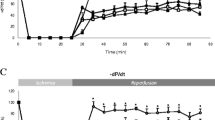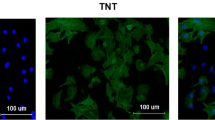Summary
Emerging evidence indicates that ischemic preconditioning (IPC) induces autophagy which attenuates myocardial ischemia/reperfusion (I/R) injury. However, the precise mechanisms remain complex and unclear. The present study was to investigate which autophagy pathway was involved in the cardioprotection induced by IPC, so that we can acquire an attractive treatment way for ischemic heart disease. Adult male Sprague-Dawley (SD) rats were randomly divided into sham group, I/R group and IPC group. IPC was induced with three cycles of 5 min regional ischemia alternating with 5 min reperfusion in a heart I/R model. Samples were taken from the center of the infracted heart and examined by using the electron microscopy, the terminal deoxynucleotidyl transferase-mediated nick end-labeling (TUNEL) method, Western blotting and co-immunoprecipitation (Co-IP). A large number of autophagic vacuoles were observed in the cardiomyocytes of IPC group as compared with I/R group. LC3-II formation, an autophagy marker, was up-regulated in IPC group as compared with I/R group (P<0.05). Moreover, the interaction between Beclin 1 and Bcl-2 was significantly increased in IPC group as compared with I/R group (P<0.01). It was also found that IPC decreased I/R-induced apoptosis (P<0.01). These results suggest that IPC inhibits Beclin 1-dependent excessive autophagy in reperfusion phase and cooperates with anti-apoptosis pathway to diminish the cell death induced by the myocardial I/R injury.
Similar content being viewed by others
References
Braunwald E, Kloner RA. Myocardial reperfusion: a double-edged sword? J Clin Invest, 1985,76(5): 1713–1719
Depre C, Vatner SF. Cardioprotection in stunned and hibernating myocardium. Heart Fail Rev, 2007,12(3–4): 307–317
Kostin S, Pool L, Elsässer A, et al. Myocytes die by multiple mechanisms in failing human hearts. Circ Res, 2003,92(7):715–724
Hein S, Arnon E, Kostin S, et al. Progression from compensated hypertrophy to failure in the pressure-overloaded human heart: structural deterioration and compensatory mechanisms. Circulation, 2003,107(7): 984–991
Gottlieb RA, Finley KD, Mentzer RM Jr. Cardioprotection requires taking out the trash. Basic Res Cardiol, 2009,104(2):169–180
Levine B, Kroemer G. Autophagy in the pathogenesis of disease. Cell, 2008,132(1):27–42
Maiuri MC, Zalckvar E, Kimchi A, et al. Self-eating and self-killing: crosstalk between autophagy and apoptosis. Nat Rev Mol Cell Biol, 2007,8(9):741–752
Mizushima N, Levine B, Cuervo AM, et al. Autophagy fights disease through cellular self-digestion. Nature, 2008,451(7182):1069–1075
Rodriguez-Enriquez S, Kim I, Currin RT, et al. Tracker dyes to probe mitochondrial autophagy (mitophagy) in rat hepatocytes. Autophagy, 2006,2(1):39–46
Boya P, González-Polo RA, Casares N, et al. Inhibition of macroautophagy triggers apoptosis. Mol Cell Biol, 2005,25(3):1025–1040
Lum JJ, Bauer DE, Kong M, et al. Growth factor regulation of autophagy and cell survival in the absence of apoptosis. Cell, 2005,120(2):237–248
Lee J, Giordano S, Zhang J. Autophagy, mitochondria and oxidative stress: cross-talk and redox signalling. Biochem J, 2012,441(2):523–540
Gustafsson AB, Gottlieb RA. Mechanisms of apoptosis in the heart. J Clin Immunol, 2003,23(6):447–459
Hamacher-Brady A, Brady NR, Logue SE, et al. Response to myocardial ischemia/reperfusion injury involves Bnip3 and autophagy. Cell Death Differ, 2007,14(1):146–157
Yan L, Vatner DE, Kim SJ, et al. Autophagy in chronically ischemic myocardium. Proc Natl Acad Sci USA, 2005,102(39):13 807–13 812
Hamacher-Brady A, Brady NR, Gottlieb RA. Enhancing macroautophagy protects against ischemia/reperfusion injury in cardiac myocytes. J Biol Chem, 2006,281(40): 29 776–29 787
Ryter SW, Lee SJ, Smith A, et al. Autophagy in vascular disease. Proc Am Thorac Soc, 2010,7(1):40–47
Pattingre S, Tassa A, Qu X, et al. Bcl-2 antiapoptotic proteins inhibit Beclin 1-dependent autophagy. Cell, 2005,122(6):927–939
Itakura E, Kishi C, Inoue K, et al. Beclin 1 forms two distinct phosphatidylinositol 3-kinase complexes with mammalian Atg14 and UVRAG. Mol Biol Cell, 2008,19(12):5360–5372
Furuya N, Yu J, Byfield M, et al. The evolutionarily conserved domain of Beclin 1 is required for Vps34 binding, autophagy and tumor suppressor function. Autophagy, 2005,1(1):46–52
Oberstein A, Jeffrey PD, Shi Y. Crystal structure of the Bcl-XL-Beclin 1 peptide complex: Beclin 1 is a novel BH3-only protein. J Biol Chem, 2007,282(17):13 123–13 132
Maiuri MC, Le Toumelin G, Criollo A, et al. Functional and physical interaction between Bcl-X(L) and a BH3-like domain in Beclin1. EMBO J, 2007,26(10): 2527–2539
Oh S, Xiaofei E, Ni D, et al. Downregulation of autophagy by Bcl-2 promotes MCF7 breast cancer cell growth independent of its inhibition of apoptosis. Cell Death Differ, 2011,18(3):452–464
Huang C, Yitzhaki S, Perry CN, et al. Autophagy induced by ischemic preconditioning is essential for cardioprotection. J Cardiovasc Transl Res, 2010,3(4):365–373
Yang X, Cohen MV, Downey JM. Mechanism of cardioprotection by early ischemic preconditioning. Cardiovasc Drugs Ther, 2010,24(3):225–234
Downey JM, Krieg T, Cohen MV. Mapping preconditioning’s signaling pathways: an engineering approach. Ann N Y Acad Sci, 2008,1123:187–196
Jones SP, Bolli R. The ubiquitous role of nitric oxide in cardioprotection. J Mol Cell Cardiol, 2006,40(1):16–23
Pain T, Yang XM, Critz SD, et al. Opening of mitochondrial K (ATP) channels triggers the preconditioned state by generating free radicals. Circ Res, 2000,87(6):460–466
Matsui Y, Takagi H, Qu X, et al. Distinct roles of autophagy in the heart during ischemia and reperfusion: roles of AMP-activated protein kinase and Beclin 1 in mediating autophagy. Circ Res, 2007,100(6):914–922
Brocheriou V, Hagège AA, Oubenaïssa A. Cardiac functional improvement by a human Bcl-2 transgene in a mouse model of ischemia/reperfusion injury. J Gene Med, 2000,2(5):326–333
Imahashi K, Schneider MD, Steenbergen C. Transgenic expression of Bcl-2 modulates energy metabolism, prevents cytosolicacidification during ischemia, and reduces ischemia/reperfusion injury. Circ Res, 2004,95 (7):734–741
Hochhauser E, Kivity S, Offen D, et al. Bax ablation protects against myocardial ischemia-reperfusion injury in transgenic mice. Am J Physiol Heart Circ Physiol, 2003,284(6):H2351–H2359
Levine B, Sinha S, Kroemer G. Bcl-2 family members: dual regulators of apoptosis and autophagy. Autophagy, 2008,4(5):600–606
Liang C, Feng P, Ku B, et al. Autophagic and tumour suppressor activity of a novel Beclin1-binding protein UVRAG. Nat Cell Biol, 2006,8(7):688–699
Zhu Y, Zhao L, Liu L, et al. Beclin 1 cleavage by caspase-3 inactivates autophagy and promotes apoptosis. Protein Cell, 2010,1(5):468–477
Author information
Authors and Affiliations
Corresponding author
Additional information
The authors contributed equally to this work.
Rights and permissions
About this article
Cite this article
Peng, W., Liu, Y., Xu, Wj. et al. Role of beclin 1-dependent autophagy in cardioprotection of ischemic preconditioning. J. Huazhong Univ. Sci. Technol. [Med. Sci.] 33, 51–56 (2013). https://doi.org/10.1007/s11596-013-1070-6
Received:
Published:
Issue Date:
DOI: https://doi.org/10.1007/s11596-013-1070-6




